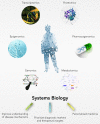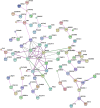Copy Number Variations in Amyotrophic Lateral Sclerosis: Piecing the Mosaic Tiles Together through a Systems Biology Approach
- PMID: 28120152
- PMCID: PMC5820374
- DOI: 10.1007/s12035-017-0393-x
Copy Number Variations in Amyotrophic Lateral Sclerosis: Piecing the Mosaic Tiles Together through a Systems Biology Approach
Abstract
Amyotrophic lateral sclerosis (ALS) is a devastating and still untreatable motor neuron disease. Despite the molecular mechanisms underlying ALS pathogenesis that are still far from being understood, several studies have suggested the importance of a genetic contribution in both familial and sporadic forms of the disease. In addition to single-nucleotide polymorphisms (SNPs), which account for only a limited number of ALS cases, a consistent number of common and rare copy number variations (CNVs) have been associated to ALS. Most of the CNV-based association studies use a traditional candidate-gene approach that is inadequate for uncovering the genetic architectures of complex traits like ALS. The emergent paradigm of "systems biology" may offer a new perspective to better interpret the wide spectrum of CNVs in ALS, enabling the characterization of the complex network of gene products underlying ALS pathogenesis. In this review, we will explore the landscape of CNVs in ALS, putting specific emphasis on the functional impact of common CNV regions and genes consistently associated with increased risk of developing disease. In addition, we will discuss the potential contribution of multiple rare CNVs in ALS pathogenesis, focusing our attention on the complex mechanisms by which these proteins might impact, individually or in combination, the genetic susceptibility of ALS. The comprehensive detection and functional characterization of common and rare candidate risk CNVs in ALS susceptibility may bring new pieces into the intricate mosaic of ALS pathogenesis, providing interesting and important implications for a more precise molecular biomarker-assisted diagnosis and more effective and personalized treatments.
Keywords: Amyotrophic lateral sclerosis (ALS); Copy number variations (CNVs); Genomics; Systems biology.
Conflict of interest statement
The authors declare that they have no conflict of interest.
Figures






Similar articles
-
Copy-number variation in sporadic amyotrophic lateral sclerosis: a genome-wide screen.Lancet Neurol. 2008 Apr;7(4):319-26. doi: 10.1016/S1474-4422(08)70048-6. Epub 2008 Mar 3. Lancet Neurol. 2008. PMID: 18313986
-
Increased copy-number variant load of associated risk genes in sporadic cases of amyotrophic lateral sclerosis.Cell Mol Life Sci. 2024 Jul 27;81(1):316. doi: 10.1007/s00018-024-05335-8. Cell Mol Life Sci. 2024. PMID: 39066921 Free PMC article.
-
The role of copy number variation in susceptibility to amyotrophic lateral sclerosis: genome-wide association study and comparison with published loci.PLoS One. 2009 Dec 4;4(12):e8175. doi: 10.1371/journal.pone.0008175. PLoS One. 2009. PMID: 19997636 Free PMC article.
-
Copy number variability in Parkinson's disease: assembling the puzzle through a systems biology approach.Hum Genet. 2017 Jan;136(1):13-37. doi: 10.1007/s00439-016-1749-4. Epub 2016 Nov 28. Hum Genet. 2017. PMID: 27896429 Free PMC article. Review.
-
[Personal genome analysis in amyotrophic lateral sclerosis].Brain Nerve. 2013 Mar;65(3):257-65. Brain Nerve. 2013. PMID: 23475517 Review. Japanese.
Cited by
-
Metabolic and behavioral features of acute hyperpurinergia and the maternal immune activation mouse model of autism spectrum disorder.PLoS One. 2021 Mar 18;16(3):e0248771. doi: 10.1371/journal.pone.0248771. eCollection 2021. PLoS One. 2021. PMID: 33735311 Free PMC article.
-
SOD1/Rag2 Mice with Low Copy Number of SOD1 Gene as a New Long-Living Immunodeficient Model of ALS.Sci Rep. 2019 Jan 28;9(1):799. doi: 10.1038/s41598-018-37235-w. Sci Rep. 2019. PMID: 30692571 Free PMC article.
-
Integrative multi-omic analysis identifies new drivers and pathways in molecularly distinct subtypes of ALS.Sci Rep. 2019 Jul 10;9(1):9968. doi: 10.1038/s41598-019-46355-w. Sci Rep. 2019. PMID: 31292500 Free PMC article.
-
Copy Number Variations in Hereditary Spastic Paraplegia-Related Genes: Evaluation of an Iranian Hereditary Spastic Paraplegia Cohort and Literature Review.Mol Syndromol. 2023 Dec;14(6):477-484. doi: 10.1159/000531507. Epub 2023 Jul 7. Mol Syndromol. 2023. PMID: 38058755 Free PMC article.
-
System biology and bioinformatics pipeline to identify comorbidities risk association: Neurodegenerative disorder case study.PLoS One. 2021 May 6;16(5):e0250660. doi: 10.1371/journal.pone.0250660. eCollection 2021. PLoS One. 2021. PMID: 33956862 Free PMC article.
References
-
- van Es MA, Van Vught PW, Blauw HM, Franke L, Saris CG, Andersen PM, Van Den Bosch L, de Jong SW, et al. ITPR2 as a susceptibility gene in sporadic amyotrophic lateral sclerosis: a genome-wide association study. The Lancet Neurology. 2007;6(10):869–877. doi: 10.1016/S1474-4422(07)70222-3. - DOI - PubMed
Publication types
MeSH terms
Grants and funding
LinkOut - more resources
Full Text Sources
Other Literature Sources
Medical
Miscellaneous

